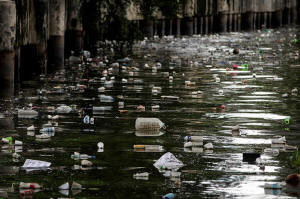Chemicals in plastics far more numerous than previous estimates, report
says
 Send a link to a friend
Send a link to a friend
 [March 15, 2024]
By Gloria Dickie [March 15, 2024]
By Gloria Dickie
LONDON (Reuters) -At least 3,000 more chemicals are in plastics — from
food packaging to toys to medical devices — than previously estimated by
environmental agencies, a report published on Thursday found, raising
questions over pollution and consumer safety.
While the United Nations Environment Programme (UNEP) had previously
identified around 13,000 plastic chemicals, the report by a team of
European scientists found more than 16,000 chemicals in plastics — a
quarter of which are thought to be hazardous to human health and the
environment.
The report, funded by the Norwegian Research Council, comes as
government negotiators grapple with devising the world's first treaty to
tackle mounting plastic pollution, as some 400 million tonnes of plastic
waste are produced every year.
"To robustly solve plastic pollution, you actually have to look at the
full life cycle of plastics and you have to address the chemicals
issue," said report co-author Jane Muncke, managing director of the
Swiss nonprofit Food Packaging Forum.
That's because plastic chemicals can leach into water and food.

"We're finding hundreds, if not thousands, of plastic chemicals in
people now and some of them have been linked to adverse health
outcomes," Muncke said.
Such impacts include fertility issues and cardiovascular disease.
"When we look into ... products that we're using on a daily basis, we
usually find between hundreds, if not thousands of chemicals in an
individual plastic product," said lead author Martin Wagner, an
environmental toxicologist at the Norwegian University of Science and
Technology.
Kimberly Wise White, vice president of regulatory and technical affairs
for the American Chemistry Council, an industry group whose membership
is dominated by plastics makers, said the findings sought to "advance a
hazard framework that ignores real-world exposures and paints an
incomplete picture for regulators and the public."
[to top of second column]
|

Plastic bottles float on the heavily polluted San Juan River, a
tributary of Pasig River in Mandaluyong City, Philippines, June 21,
2021. Picture taken June 21, 2021. REUTERS/Eloisa Lopez/File Photo

While the plastics industry has said any global treaty should
promote recycling and re-use of plastic, only addressing plastic
waste doesn't go far enough to protect people, the report's authors
said.
Scientists flagged the need for greater transparency on what
chemicals — including additives, processing aids, and impurities —
are going into plastics - including recycled products.
A quarter of the identified chemicals lack basic information on
their basic chemical identity, the report said.
"At the core of the problem is the chemical complexity of plastics,"
said Wagner, who also serves on the board of the Scientists'
Coalition for an Effective Plastics Treaty.
"Often producers don't really know which kind of chemicals they have
in their products and that comes from very complex value chains."
Only 6% of the chemicals found in plastics are regulated
internationally. Without regulatory pressure, "there is no
motivation to disclose what's in the plastics," he said.
That's something a plastics treaty could help to address.
Negotiations continue next month in Ottawa, Canada, with the aim of
finalizing a treaty come December in the South Korean city of Busan.
(Reporting by Gloria Dickie, Editing by William Maclean)
[© 2024 Thomson Reuters. All rights reserved.]This material
may not be published, broadcast, rewritten or redistributed.
Thompson Reuters is solely responsible for this content.
 |